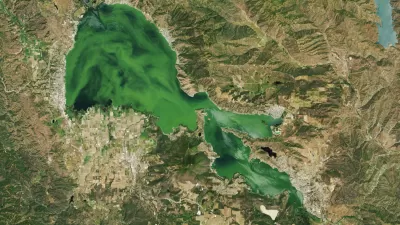Scientists hope to use AI and machine learning models to forecast water quality issues caused by toxic blue-green algae blooms.

According to the Los Alamos Reporter, scientists from the Los Alamos National Laboratory plan to use artificial intelligence modeling to forecast toxic algal blooms, which “[f]ueled by climate change and rising water temperatures … have grown in intensity and frequency” and “have now been reported in all 50 U.S. states.” Perhaps the most well-known occurrence of these harmful algal blooms, or HABs, happened in 2014, when dangerous toxin levels in Lake Erie forced Toledo, Ohio, to shut down the drinking water supply of a half-million residents for three days. Just last month, Clear Lake in California was in the news for its own blue-green algal bloom, which some fear will impact summer tourism activities.
“For decades, scientists have understood that elevated water temperatures, combined with sudden infusions of nutrients (often phosphorous and nitrogen runoff from industrial farming), tend to precede a HAB event …. But what causes toxic cyanobacteria to prevail in these freshwater ecosystems has proved challenging to understand” because they are “complex ecosystems influenced by hundreds — sometimes thousands — of other microorganisms,” the Los Alamos Reporter article reads. Armed with masses of data on HABs collected since 1954 by a variety of organizations across the nation and the world, the scientists plan to feed existing yet disparate information into a data learning model and use AI to decipher and analyze it.
“Such a model could then be used to forecast algal blooms, and possibly even predict how climate change will alter their intensity and frequency in the future,” said Babetta Marrone, senior scientist at the LANL and the project’s team lead, in a press release.
FULL STORY: LANL: AI Can Help Forecast Toxic ‘Blue-Green Tides’

Planetizen Federal Action Tracker
A weekly monitor of how Trump’s orders and actions are impacting planners and planning in America.

Canada vs. Kamala: Whose Liberal Housing Platform Comes Out on Top?
As Canada votes for a new Prime Minister, what can America learn from the leading liberal candidate of its neighbor to the north?

The Five Most-Changed American Cities
A ranking of population change, home values, and jobs highlights the nation’s most dynamic and most stagnant regions.

San Diego Adopts First Mobility Master Plan
The plan provides a comprehensive framework for making San Diego’s transportation network more multimodal, accessible, and sustainable.

Housing, Supportive Service Providers Brace for Federal Cuts
Organizations that provide housing assistance are tightening their purse strings and making plans for maintaining operations if federal funding dries up.

Op-Ed: Why an Effective Passenger Rail Network Needs Government Involvement
An outdated rail network that privileges freight won’t be fixed by privatizing Amtrak.
Urban Design for Planners 1: Software Tools
This six-course series explores essential urban design concepts using open source software and equips planners with the tools they need to participate fully in the urban design process.
Planning for Universal Design
Learn the tools for implementing Universal Design in planning regulations.
Village of Glen Ellyn
Central Transportation Planning Staff/Boston Region MPO
Heyer Gruel & Associates PA
Institute for Housing and Urban Development Studies (IHS)
City of Grandview
Harvard GSD Executive Education
Regional Transportation Commission of Southern Nevada
Toledo-Lucas County Plan Commissions





























